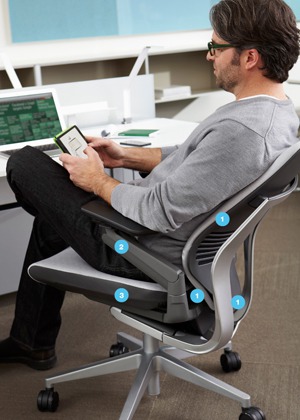The first chair designed to support our interactions with today’s technologies. Inspired by the movement of the human body. Created for the way we work today.
Technology is the single greatest force driving the changes in the way we work and live. The new, multiple devices we employ throughout our work day allow us to flow between tasks, fluidly and frequently. Gesture is the first chair designed to support our interactions with today’s technologies. Inspired by the movement of the human body. Created for the way we work today.
RESEARCH: GLOBAL POSTURE STUDY Our global study was conducted by Steelcase WorkSpace Futures and the Steelcase Design Studio. We undertook a global posture study in 11 countries, observing 2000 people in a wide range of postures, and uncovered nine new postures as a result of new technologies and new behaviors. We studied how the human body interacts with technologies and how it responds as workers shift from one device to another. Research revealed ergonomic implications that, if not adequately addressed, can cause pain and discomfort for workers.  Because these new postures are not adequately supported, workers are uncomfortable, in pain and doing long-term harm to their bodies. While technology helps productivity, it can cause pain that disrupts our work, our ability to concentrate and be creative. Based on this research, we designed Gesture to support posture changes specifically influenced by technology devices we use today.
Because these new postures are not adequately supported, workers are uncomfortable, in pain and doing long-term harm to their bodies. While technology helps productivity, it can cause pain that disrupts our work, our ability to concentrate and be creative. Based on this research, we designed Gesture to support posture changes specifically influenced by technology devices we use today.
Design: Inspired by the Human Body
We didn’t start with a chair design. We started by looking at the unique movements and gestures of the body. Like the human body, Gesture is designed as a system of synchronized interfaces.
- The Gesture back and seat move as a synchronized system that creates a tailored fit, moving with each user to provide continuous and persistent lumbar support.
- The back cradles a user no matter the device or posture.
2) The Limb Interface:
- The Gesture arm moves like the human arm, which allows users to get closer to their work. The users arms and shoulders remain supported when texting on a smartphone, typing on a keyboard or swiping a tablet.
- The Gesture arms are intentionally mounted behind the hip to support a wider range of postures and people.
3) The Seat Interface:
- The Gesture seat is contoured, distributing weight and making it comfortable over a long period of time.
- It is flexible at the perimeter to allow a range of postures without pinching or cutting off circulation of the legs.
The User Interface:
- Gesture takes into account various body types and sitting preferences, adjusting to meet the needs of each individual user.
- Users can quickly and easily adjust Gesture as easily as adjusting their posture.
Click here for additional information and resources.


















